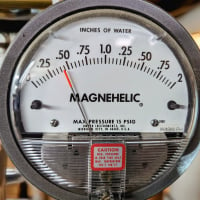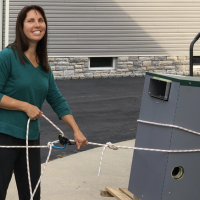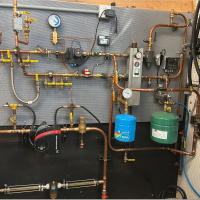Welcome! Here are the website rules, as well as some tips for using this forum.
Need to contact us? Visit https://heatinghelp.com/contact-us/.
Click here to Find a Contractor in your area.
If our community has helped you, please consider making a contribution to support this website. Thanks!
Typical electricity usage of oil boiler and accessories
Options
asherraph
Member Posts: 1
in Oil Heating
I've been trying to understand where the electricity in my new house goes. Looking at smart meter data for usage overnight and before we moved in, I've found that at minimum it's consuming 800 watts (data is in 15 minute increments and the lowest it's ever gotten to is .2 kWh). There's probably 200-300 watts accounted for, leaving at least 500 watts still to explain.
The one thing I haven't been able to account for is the heating system. I have a W-M WGO-4 oil boiler from 2013, 2 Taco circulators pushing to 4 heating zones (one indirect water heater), a few honeywell zone valves, and the oil pump. How much electricity is this stuff typically using? Continuous draw I mean, not for startup. Is it ongoing, or sporadic when the thermostat calls for heat? I would imagine the only thing going all the time is the electricity to run the boiler itself, right?
Any insights here appreciated, thanks!
The one thing I haven't been able to account for is the heating system. I have a W-M WGO-4 oil boiler from 2013, 2 Taco circulators pushing to 4 heating zones (one indirect water heater), a few honeywell zone valves, and the oil pump. How much electricity is this stuff typically using? Continuous draw I mean, not for startup. Is it ongoing, or sporadic when the thermostat calls for heat? I would imagine the only thing going all the time is the electricity to run the boiler itself, right?
Any insights here appreciated, thanks!
0
Comments
-
It can add up very quick.
A Taco 007 has a .7 ampdraw = 70 watts. A Larger Taco may draw 170 watts each.
Transformers and as you mentioned the oil burner motor.
also keep in mind that equipment such as a refrigerator may cycle on a night.0 -
A typical refrigerator should consume around 100-150 watts for half an hour every so often. However it's defrost heater consumes quite a bit and likely runs once a day regardless of who's home or using it.
That's if there was a refrigerator running in the house.
Electric water heater?Single pipe 392sqft system with an EG-40 rated for 325sqft and it's silent and balanced at all times.
0 -
Typical residential refrigerators go into defrost every 6 - 8 hour. For how long depends on the amount of ice inside.0
-
Aren't they just on a manual timer that doesn't care if there's any frost at all?pecmsg said:Typical residential refrigerators go into defrost every 6 - 8 hour. For how long depends on the amount of ice inside.
Single pipe 392sqft system with an EG-40 rated for 325sqft and it's silent and balanced at all times.
0 -
259 watts or so would be a decent guess for a reasonably sized oil burner.Br. Jamie, osb
Building superintendent/caretaker, 7200 sq. ft. historic house museum with dependencies in New England0 -
-
And what about the little guy inside the refrigerator that turns the light on for you? What does he do all that time the light is off? I think he stole my Netflix password and is currently streaming old Jack Ryan episodes.
Just food for thought. Get it? Food... Refrigerator... Food... Refrigerator, where you keep the food!Edward Young Retired
After you make that expensive repair and you still have the same problem, What will you check next?
0 -
I just installed a backup system in a gas boiler. The transformer and controls draw 25 watts and a Taco 007 circulator draws 88 watts. Not sure about the oil burner but these numbers are from measurements.0
-
Zone valves are about 5 watts when they are powered open, 70- 80 W for a typical circulator. Consumption on those when a heat call. The boiler probably has a transformer powered all the time
If the boiler, pump and controls are on one plug or circuit, those Kill O Watt tools will record power usage..
When components need replacing, ECM circulators use 1/2 or less power, 250 milliamp zone valves are available alsoBob "hot rod" Rohr
trainer for Caleffi NA
Living the hydronic dream0
Categories
- All Categories
- 87.3K THE MAIN WALL
- 3.2K A-C, Heat Pumps & Refrigeration
- 61 Biomass
- 429 Carbon Monoxide Awareness
- 120 Chimneys & Flues
- 2.1K Domestic Hot Water
- 5.8K Gas Heating
- 115 Geothermal
- 166 Indoor-Air Quality
- 3.7K Oil Heating
- 77 Pipe Deterioration
- 1K Plumbing
- 6.5K Radiant Heating
- 395 Solar
- 15.7K Strictly Steam
- 3.4K Thermostats and Controls
- 56 Water Quality
- 51 Industry Classes
- 50 Job Opportunities
- 18 Recall Announcements






